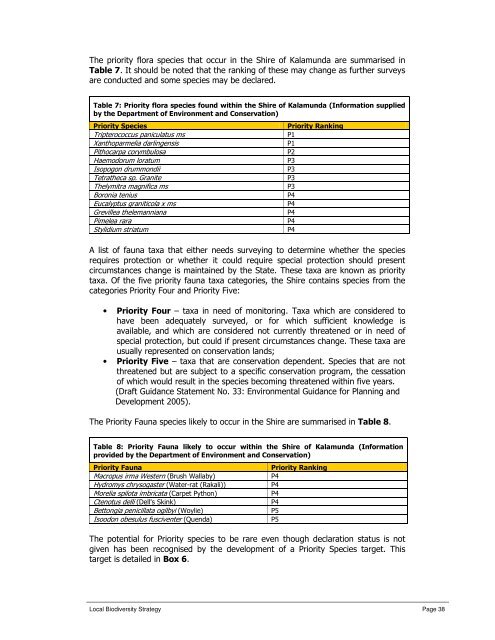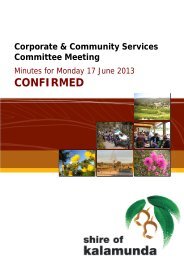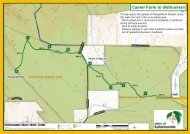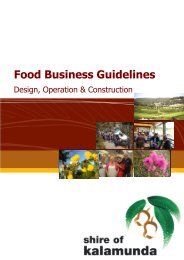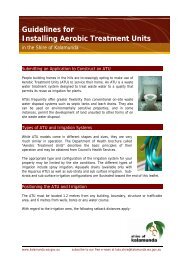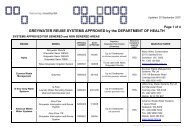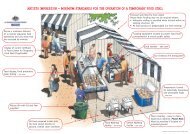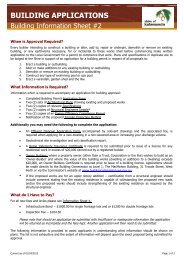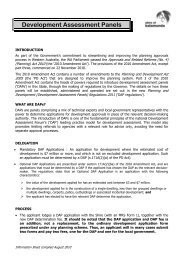Local Biodiversity Strategy: - Shire of Kalamunda
Local Biodiversity Strategy: - Shire of Kalamunda
Local Biodiversity Strategy: - Shire of Kalamunda
You also want an ePaper? Increase the reach of your titles
YUMPU automatically turns print PDFs into web optimized ePapers that Google loves.
The priority flora species that occur in the <strong>Shire</strong> <strong>of</strong> <strong>Kalamunda</strong> are summarised in<br />
Table 7. It should be noted that the ranking <strong>of</strong> these may change as further surveys<br />
are conducted and some species may be declared.<br />
Table 7: Priority flora species found within the <strong>Shire</strong> <strong>of</strong> <strong>Kalamunda</strong> (Information supplied<br />
by the Department <strong>of</strong> Environment and Conservation)<br />
Priority Species<br />
Tripterococcus paniculatus ms<br />
Xanthoparmelia darlingensis<br />
Pithocarpa corymbulosa<br />
Haemodorum loratum<br />
Isopogon drummondii<br />
Tetratheca sp. Granite<br />
Thelymitra magnifica ms<br />
Boronia tenius<br />
Eucalyptus graniticola x ms<br />
Grevillea thelemanniana<br />
Pimelea rara<br />
Stylidium striatum<br />
Priority Ranking<br />
P1<br />
P1<br />
P2<br />
P3<br />
P3<br />
P3<br />
P3<br />
P4<br />
P4<br />
P4<br />
P4<br />
P4<br />
A list <strong>of</strong> fauna taxa that either needs surveying to determine whether the species<br />
requires protection or whether it could require special protection should present<br />
circumstances change is maintained by the State. These taxa are known as priority<br />
taxa. Of the five priority fauna taxa categories, the <strong>Shire</strong> contains species from the<br />
categories Priority Four and Priority Five:<br />
• Priority Four – taxa in need <strong>of</strong> monitoring. Taxa which are considered to<br />
have been adequately surveyed, or for which sufficient knowledge is<br />
available, and which are considered not currently threatened or in need <strong>of</strong><br />
special protection, but could if present circumstances change. These taxa are<br />
usually represented on conservation lands;<br />
• Priority Five – taxa that are conservation dependent. Species that are not<br />
threatened but are subject to a specific conservation program, the cessation<br />
<strong>of</strong> which would result in the species becoming threatened within five years.<br />
(Draft Guidance Statement No. 33: Environmental Guidance for Planning and<br />
Development 2005).<br />
The Priority Fauna species likely to occur in the <strong>Shire</strong> are summarised in Table 8.<br />
Table 8: Priority Fauna likely to occur within the <strong>Shire</strong> <strong>of</strong> <strong>Kalamunda</strong> (Information<br />
provided by the Department <strong>of</strong> Environment and Conservation)<br />
Priority Fauna<br />
Macropus irma Western (Brush Wallaby)<br />
Hydromys chrysogaster (Water-rat (Rakali))<br />
Morelia spilota imbricata (Carpet Python)<br />
Ctenotus delli (Dell's Skink)<br />
Bettongia penicillata ogilbyi (Woylie)<br />
Isoodon obesulus fusciventer (Quenda)<br />
Priority Ranking<br />
P4<br />
P4<br />
P4<br />
P4<br />
P5<br />
P5<br />
The potential for Priority species to be rare even though declaration status is not<br />
given has been recognised by the development <strong>of</strong> a Priority Species target. This<br />
target is detailed in Box 6.<br />
<strong>Local</strong> <strong>Biodiversity</strong> <strong>Strategy</strong> Page 38


